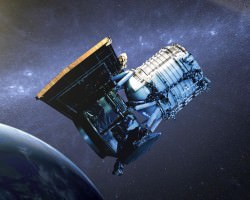On the morning of February 15, 2013, people in western Russia were dazzled by an incredibly bright meteor blazing a fiery contrail across the sky. A few minutes later a shockwave struck, shaking the buildings and blowing out windows. 1,500 people went to the hospital with injuries from shattered glass. This was the Chelyabinsk meteor, a chunk of rock that struck the atmosphere going almost 19 kilometers per second. Astronomers estimate that it was 15-20 meters across and weighed around 12,000 metric tonnes.
Here’s the crazy part. It was the largest known object to strike the atmosphere since the Tunguska explosion in 1908. Catastrophic impacts have shaped the evolution of life on Earth. Once every 65 million years or so, there’s an impact so destructive, it wipes out almost all life on Earth. The bad news is the Chelyabinsk event was a surprise. The asteroid came out of nowhere. We need to find all the potential killer asteroids, and understand what risks we face.
“I’m Ned Wright…”
That’s Dr. Ned Wright. He’s a professor of physics and astronomy at UCLA, and the Primary Investigator for the Wide-field Infrared Survey Explorer mission; a space telescope that looks for low temperature objects in the infrared spectrum.
“I think the best way to protect the Earth from asteroids is to get out and look very assiduously to find all the hazardous asteroids. Although astronomers have been finding and cataloging asteroids for decades, we still only have a fraction of the dangerous asteroids tracked. The large continent destroyers have mostly been found, but there’s a whole class of smaller, city killers out there, and they’re almost entirely unknown. There are… these dark asteroids that may not be the most dominant part of the population but they certainly can be a very hazardous subset, it’s important to do the observations in the infrared. So you actually, instead of looking for the ones that reflect the most light, you look for the ones that have the biggest area and therefore the ones that are the heaviest and can do the most damage. And so, I think that an infrared survey is the way to go.”
“In the infrared wavelengths, we can find these objects because they’re large, not because they’re bright. And to really do this right, we need a space-based infrared observatory capable of surveying vast areas of the sky, searching for anything moving.”
The WISE mission has been offline for a few years, but WISE is actually being reactivated right now to look for more Near Earth Objects, so we’re currently cooled down to 93 K, and when we get to 73 K, which is where we were when we turned off in 2011 we’ll probably be able to go out and find more Near Earth Objects.
Note: this interview was recorded in November, 2013. WISE resumed operations in December 23, 2013

But to really find the vast majority of dangerous asteroids, you need a specialized mission. One proposal is the Near Earth Asteroid Camera, or NEOCam because it’d be much better to have a telescope that was slightly colder than the 73 K WISE is with coolant, and you can do that by getting away from the Earth. and so the NEOcam telescope is designed to go a million and a half kilometers from the Earth and therefore it would be quite cold, about 35 K and at that temperature, it can operate longer into the infrared and do a very sensitive survey for asteroids.
NEOCam is just one idea. There’s also the Sentinel proposal from B612 Foundation. It’s also an infrared survey and it would go into an orbit like Venus’ orbit, so it would be hundreds of millions of km away from Earth, but not orbiting around Venus, because that would be too hot as well and then with an infrared telescope, it would survey for asteroids.
NEOCam and Sentinel would operate for years, scanning the sky in the infrared to find all of the really hazardous asteroids. You wouldn’t be able to necessarily find the ones the size of the one that hit Chelyabinsk, and so that broke some windows, but it didn’t kill people, didn’t knock buildings down. So that’s definitely a hazard, but not the city destroying hazard that a 100 meter diameter asteroid would be.
We live in a cosmic shooting gallery. Rocks from space impact the Earth all the time, our next dangerous asteroid is out there, somewhere. Let’s build a space-based infrared survey mission so we can find it, before it finds us.


Where are the killer asteroids?
Long time falling,
Where are the killer asteroids?
Good time to know,
Where are the killer asteroids?
Zooming past us everyone.
When will they smack us good?
When will they smaaaaack us good?
Agreed! We need more space telescopes dedicated to finding NEA’s and other hazards. Furthermore… wouldn’t it be great to get more eyes watching the sky?
I thought The Chelyabinsk event or Comet ISON’s passage might do the trick? But neither event did the deed. Public interest, no doubt jaded by lame stream TV’s glad handing and sensationalizing of the news(?) created only a momentary or passing interest. Too bad there wasn’t a popular upwelling of interest for astronomy… DRAT!
Like Frazer says… “The Universe OWES us a big comet!”
Lets take our telescopes to the streets and MAKE some new astronomers?
Sadly I think it will take one of at least Chelyabinsk size maybe a little larger over the US or western Europe to really spark the publics interest.
“Western Russia”? Well, somewhat. Russia or Siberia what’s the difference? It’s right north of Baikonur though.